#Mixteca Organization
Text

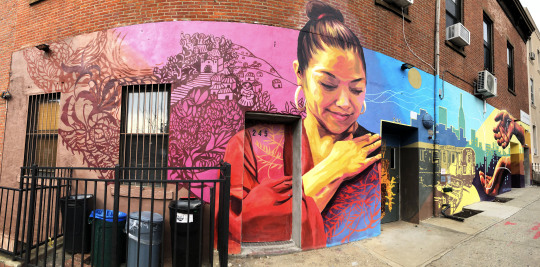


Nuestro Andar Florece by artist, muralist, arts educator and filmmaker Michelle Angela Ortiz, is located on the wall of Mixteca Organization in Brooklyn, NY. Mixteca is a community-based organization established by “a group of concerned community members to address critical needs in health, education, social and legal issues facing the burgeoning Mexican and Latin American immigrant community in Brooklyn”.
About the mural from the artist’s website-
Nuestro Andar Florece (Our Journey Blooms), celebrates the stories of Mexican immigrant women that have planted their roots in Brooklyn, New York. As part of the Barrio Roots Festival that took place in late October 2016, I led this mural project along with artist Federico Zuvire. The project was supported by Habitajes. They offered a series of creative workshops at Mixteca Organization with women that shared their immigration stories. The women are mothers, students, educators, and some survivors of domestic violence that found a new home in New York. The women decided on the messages that are conveyed in the mural. For three weeks, the artists, workshop participants, local Brooklyn artists, and neighbors participated in the creation of the mural.
#Michelle Angela Ortiz#Mixteca Organization#Brooklyn Mural#Brooklyn Murals#Brooklyn Street Art#Mixteca#Murals#NYC Murals#Public Art#Street Art#Street Art Brooklyn#Sunset Park
1 note
·
View note
Photo
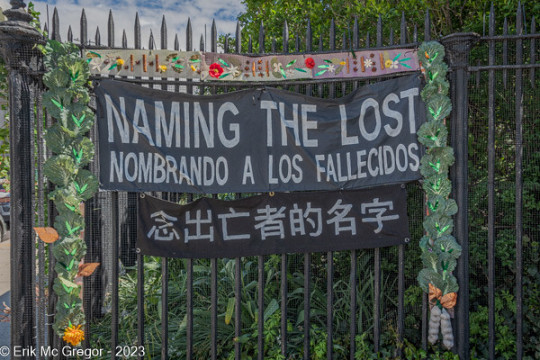

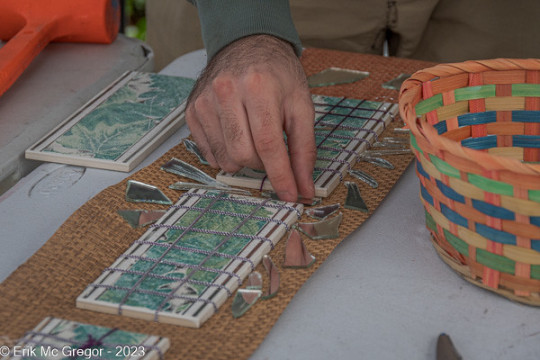
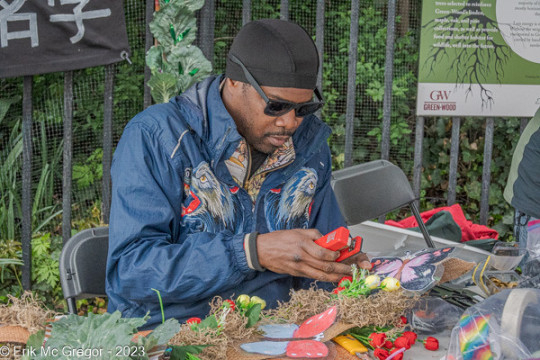

THE GREEN-WOOD CEMETERY, NAMING THE LOST MEMORIALS AND CITY LORE PUBLIC ART MEMORIAL: THE MANY LOSSES FROM COVID-19 by ERIK MCGREGOR
Via Flickr:
New York, NY - Artists and volunteer organizers across New York City in connection with Naming the Lost built memorials at the Greenwood Cemetery entrance to honor the lives lost to COVID-19 and those impacted by the pandemic, in solidarity with Americans across the country to come together in mourning to recognize and grieve for the thousands of lives lost during the pandemic. The memorial consisted of tributes made by 20 community groups from across New York City. The memorial will hold a prominent place along Green-Wood’s historic wrought-iron fence, near the Main Entrance at Fifth Avenue at 25th Street. There will be a designated area for members of the public to add their own memorial contributions. "Public COVID memorials help remind us that New Yorkers have suffered tremendous loss of life in this pandemic,” Kay Turner, the project’s consultant and an early project organizer. “We have also suffered other losses—loss of time, relationships, jobs, taste and smell. Many of our neighbors are stalled in the debilitating effects of Long COVID. NTLM creates memorials to recognize the many losses from COVID-19.” "Life’s task is the validation of memory and the passing on of memories both in our personal and collective lives. NAMING THE LOST Memorials aims to create an annual, tangible wall of memory that does not allow the lives and souls of the many thousands of victims of the Covid Pandemic to escape our thoughts—thoughts which are needed to remember, grasp our losses, and find ways to create healthier and more compassionate communities," said Steve Zeitlin, Co-Director, City Lore. “As our nation and city continue to recover from the pandemic, and as we begin to open our lives to a better future, we must always remember those whose lives have been forever changed by this pandemic, whether through the loss of loved ones or the ongoing healthcare needs of those who continue to suffer,” said Richard J. Moylan, President of Green-Wood. “Green-Wood is proud to partner with NAMING THE LOST Memorials and City Lore, as well as all of our community partners, to present this poignant memorial.” To create this memorial, NAMING THE LOST Memorials has collaborated with 20 community groups from across the city whose constituents have suffered significant losses from COVID-19. Participants include: Casa Yurumein (Bronx); Arab American Association of New York, Guyana Cultural Association, Mixteca, Museo de Los Sures, Parent Child Relationship Association, Project Reach Youth Safe, Purelements Evolution in Dance, and Women’s Empowerment Coalition of New York (Brooklyn); The City’s “Missing Them”, The W.O.W. Project, and Yaffa Cultural Arts (Manhattan); Bangladesh Institute of Performing Arts, the Jews of Jackson Heights, and International Dancer Zaman (Queens); La Colmena and Staten Island Museum (Staten Island); and Jews of Color arts workshop (“The Workshop”), Long Covid Justice, and New Moon Sisters (multiple locations throughout the city). “Naming the Lost Memorials is important because we get the opportunity to take pause, remember, and pay our respect to Guyanese and friends who have succumbed to COVID-19. We journey through the grief together, as we get a chance to honor and pay tribute to them,” said Rose October, Assistant Cultural Director, Guyana Cultural Association (GCA) of NY. Anna Roberts-Gevalt of Long Covid Justice, said, “We seek to hold space for members of our community to share their stories of sick and disabled grief, strength and hope, as we navigate the difficulties of living with our symptoms—and navigate the lack of care, help, and support.” NAMING THE LOST Memorials is a small team of artists, activists, and folklorists that has been curating memorial sites in New York City to name and remember victims of the COVID-19 pandemic since May 2020. They created homegrown memorials in a public setting to draw attention to the astounding number of COVID deaths and to give people a place to name their lost loved ones. Over Memorial Day weekend that year, public memorial sites were created across the city, including one at Green-Wood. The 2023 memorial, “THE MANY LOSSES FROM COVID-19”, will be on view beginning May 3rd and can be used as a spontaneous mourning site until May 29th. #NamingTheLost #NombrandoALosFallecidos #brooklyn #memorial #COVID19 #coronavirus #pandemic #NewYork #NYC #CityLore #ErikMcGregorPhotography #Photography #USA #GreenwoodCemetery © Erik McGregor - [email protected] - 917-225-8963
0 notes
Text
Reforestation and community building: My volunteering experience with Yuxacoyo in Santo Domingo Yanhuitlán, Mexico
Volunteering with Yuxacoyo in Santo Domingo Yanhuitlán, Mexico, was an incredible experience. When I started the Sustainability and Climate module, I knew that volunteering was going to be a challenge, as I was travelling to Mexico City to visit my family and was not going to be able to be in the UK to volunteer for a local cause before the 3 of April submission deadline. However, I didn't want this to stop me from completing the task, so I contacted a colleague from Yuxacoyo to go and volunteer on their reforestation efforts.
During the volunteering period, I visited the UNESCO-recognised Mixteca Alta Geopark to explore the geological and natural wonders of the Sierra Madre, and I also participated in a pottery workshop with the artisans of the community of Vista Hermosa.
The experience was both enjoyable and challenging. I worked with local students and teachers on various maintenance, cleaning, and repair work on the CBTA facilities during the day of tequio, and on the most intense day, I participated in the workday with the Yuxacoyo organisation, collaborating in the reforestation of the Quedana hill and harvesting organic products.
Given the lack of support and understanding on the part of the federal and state environmental authorities, some community greenhouses have been set up in which plants are produced for reforestation from seeds collected in the same places where they are planted. These plants are the ones we used to plant on the Quedana hill.
Volunteering with Yuxacoyo allowed me to learn more about the voluntary sector, the organisation, and myself. I learned that grassroots organisations are instrumental in promoting change in communities, as the lack of support and understanding from the federal and state environmental authorities surprised me.
The experience inspired me to continue giving back to communities and promoting change through volunteering. It also renewed my connection with the Yanhuitlán community and gave me the satisfaction of knowing that my efforts would contribute to counteracting deforestation in the region.
In conclusion, volunteering with Yuxacoyo was a valuable experience that allowed me to reconnect with the Yanhuitlán community and learn from different experiences. It has motivated me to continue volunteering and promoting change in communities.
Champion for Change: Making the World a Better place
Course: Volunteering with Social Impact
Activity: Short Blog Exercise
0 notes
Text
The Dominican Route III - Yanhuitlan
Our last stop of the day was at Yanhuitlan. We pulled up at a few minutes before 5 PM. We headed into the church right away and they closed the doors behind us. The rest of the exterior would have to wait until we were either done inside or tossed out.
The church sits on a large platform what was originally the base of a local pre-Columbian temple. This connected it to a previous holy site, provided a good foundation, and stones from the previous temple to use in construction.
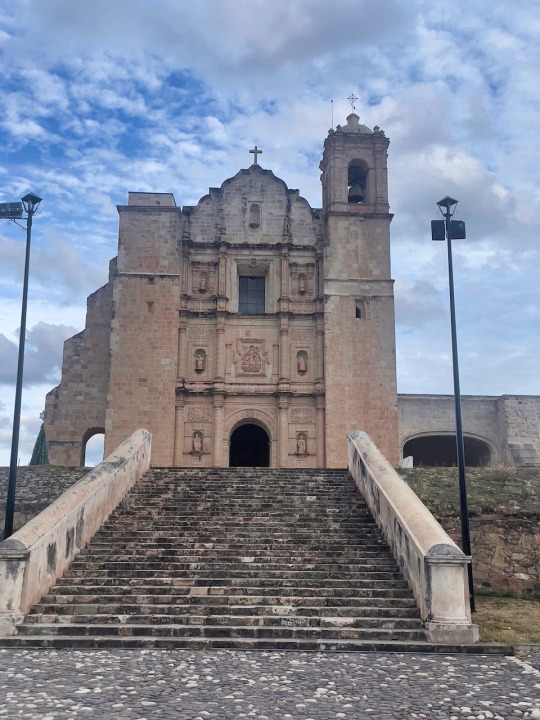
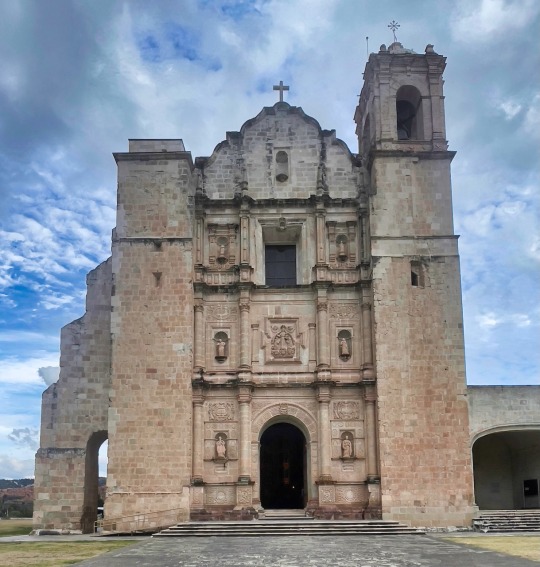
If you are not hurrying to get inside you might notice at this point that the church is taller than the others. If not you will when you get inside. Because, wow, it's tall! Apparently its one of the tallest in Mexico. Then you notice that it's not a round vault its slightly peaked like a Gothic vault, also unusual in Mexico. The effect is stunning! It took some guts to build something this tall in an earthquake zone.
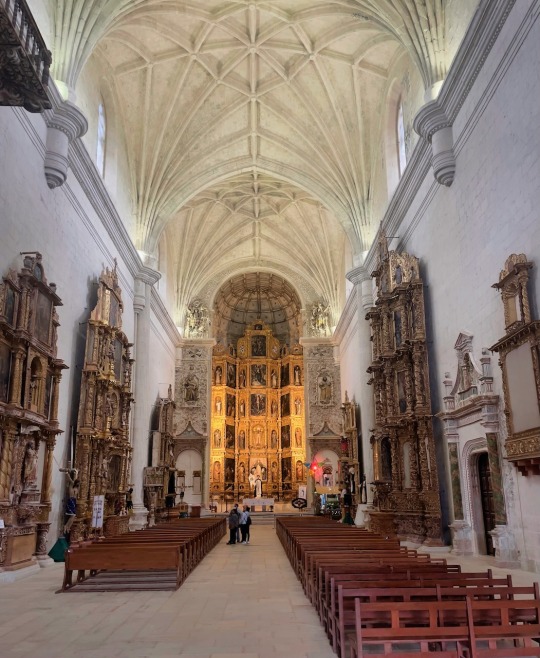
The retablo behind the altar is also hugely tall, and sits in a semicircular alcove under a dome. It's also been beautifully restored and even the paintings cleaned.
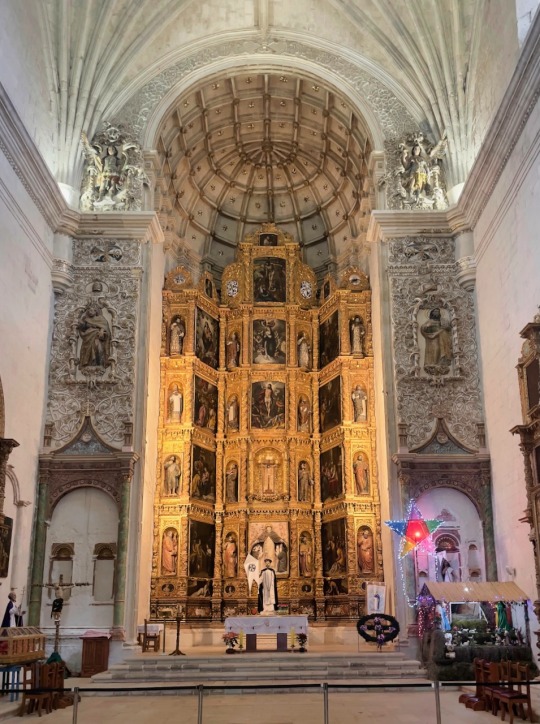
The figures of the saints on either side and the design of the wall are also beautiful.

The pipe organ looked to also be fully restored, at least all the pipes looked to be in place.

They were particular to point out to us the figure of Jesus on the cross is not the typical dying version with the bleeding wound and the drooping head. Here he is alert with his head up. A living Jesus.

In a side chapel there is a unique representation of them taking Jesus down from the cross. It's carve in Mexican Onyx and the painted. Again unlike anything else I've seen.

By this time they were hustling us out. So we went out the side door onto the large platform. The side doors are used frequently for processions so are also fully detailed.

This church was stunning and apparently the local community took the lead on the restoration getting the funding and making decisions. They did a great job.
There is also a restored monastery next door, but we were too late to get in there.
We then went down behind the church to the area of the zocalo and market. At the base of the platform there was a channel for water distribution and a small structure for people to get fresh water.
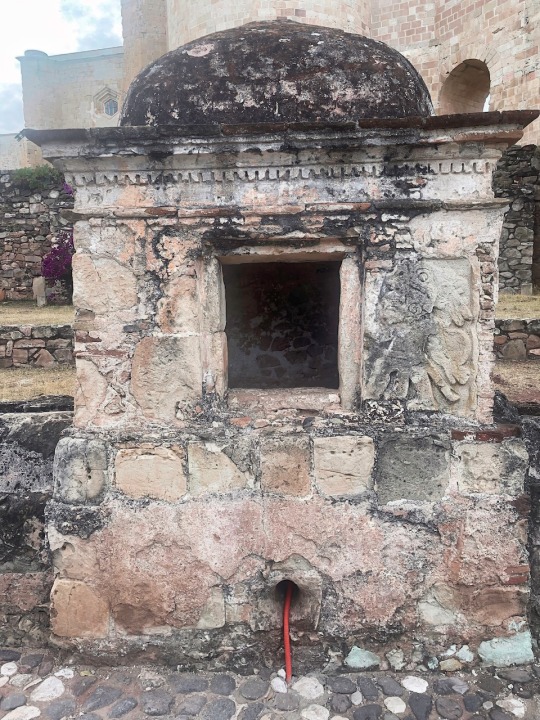
It was interesting to note the carving on the right side. That's definitely pre-Columbian. Interesting that they were allowed to use that at a church. Must be an interesting story we will never know.

From here we could see that cylindrical alcove behind the altar.
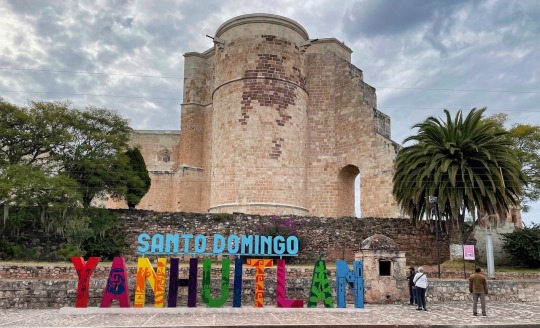
The sky was darkening and we had over an hour drive to get back to Oaxaca so it was time to head back.
We had a long but very interesting day. For those interested in colonial churches and architecture, it is well worth a day or even more to go to the Mixteca highlands, see the churches and the landscape, and learn some of the history.
0 notes
Link
In Tepejillo, on one of the many hills in the southern Mexican municipality of San Juan Bautista Coixtlahuaca, extreme erosion has transformed the earth into bare rock, making it difficult to imagine that the area used to be home to a forest or, even more incredibly, a civilization.
“These forests supported a city of more than 100,000 residents before the arrival of the Spanish,” says mayor of the Mixteca Alta region, Oaxaca state, where Tepejillo is located.
The limestone landscape, once held enough water, animals, fertile soil and trees to support the powerful Mixtec ruler of Coixtlahuaca.
Around 20 years ago, the communities here decided to start restoring water and soil fertility. Their tenacity has yielded results: From out of the karst rocks appeared green shoots of vegetation, easily mistaken for glints of sunlight in the white desert. Only by coming closer are they recognizable as pines, oaks, breadnuts and junipers, all planted here in 2021.
“To plant them, first we had to dig ditches to hold the water. To do that, we had to break ground using machinery, because it was pure rock. Sometimes even the machines couldn’t do it,” says the mayor.

The idea that these fragile seedlings would recreate a forest out of such adverse conditions seemed preposterous. But then again, the Narreje and Loma Larga sites a few kilometers away, where communal work had started 20 years earlier, were showing good results. Dense masses of forest 5 meters (16 feet) high flank the highway connecting the cities of Puebla and Oaxaca.
At least 2,000 hectares (4,900 acres) of degraded land in the agrarian community of San Juan Bautista Coixtlahuaca have been reforested through communal efforts since 2000. That’s almost three times the size of Mexico City’s Chapultepec forest, one of the largest urban parks in the Americas.
Coixtlahuaca is just one of 25 communities that form part of this reforesting miracle stretching throughout what is known as the Chocho-Mixtecas Community Alliance. Within the alliance’s territory, more than 20,000 hectares (49,000 acres) have been restored, a feat equivalent to at least three Manhattans. It’s also proof of the potential for forest restoration when an entire population gets behind the idea of working with, not against, the land.
Restoration was so successful that on June 17, 2021, the Secretary of Environment and Natural Resources (SEMARNAT) and the U.N.’s Food and Agriculture Organization (FAO) selected it to be the venue for the World Day to Combat Desertification and Drought.
Goats, everywhere
In Coixtlahuaca, like the rest of Oaxaca’s Mixteca region and other parts of Mexico, Spanish colonization led to intensive ranching that degraded every piece of land it touched. But unlike cattle or sheep, which can’t survive on poor vegetation, goats were able to feed on the plants of the degraded landscape, which are often the last barrier protecting the soil. With their strong teeth, goats can pull up plants from their roots, preventing them from regrowing. Their sharp hooves also cut into the topsoil, exposing it to erosion from rain and wind.
“Since the Spanish, this area has been full of goats, and that devastated it,” says the mayor.
Coixtlahuaca’s true environmental decline, then, started with the expansion of goat ranching and the resulting eradication of the area’s vegetation.
Most people here are aware of the consequences of overgrazing and even participating in reforestation efforts,” continues the mayor.

Starting at less than zero
Coixtlahuaca and the rest of Mixteca entered the 20th century with an eroded territory.
“But now, thanks to this work, the communities once again have water, crops, business and opportunities to prosper" states one person from the National Forestry Commission (CONAFOR) in Oaxaca.
Coixtlahuaca and other Mixteca communities didn’t have anything to take care of. There wasn’t any vegetation to restore. Instead, they had to start with the basics: crushing stones to retain moisture, and look for plants that would be strategic for regenerating the soil. The idea was to achieve something between water, soil and plants that had previously taken millions of years. “Here, we aren’t starting from zero but rather from less than zero,” says the mayor.
A forest technician who has worked in the region for more than a decade, says the focus should be on the soil more than the trees. “Normally, there is more attention given to areas with trees and where forests are exploited. Only now are the government and other entities understanding that we aren’t reforesting but rather restoring.
“Based on this work,” she adds, “I fervently believe that restoration, even in the worst of cases, is possible.”

The communities have also planted significant amounts of other species that are endemic: the smooth-bark Mexican pine (Pinus pseudostrobus). In general, the pines are fundamental as pioneering species for rapid growth and adaption to difficult conditions. This is most evident, for example, after a forest fire, as the pines are the first to grow, becoming an outpost that allows other species to develop alongside them.
If at first the goals for reforestation in the area were 10 or 20 hectares (24 or 49 acres) a year, now they’re 200 or 300 hectares (490 or 740 acres). The restoration work lasts nearly all year and starts in the dry season with the preparation of ditches and trenches, and carefully calculating the runoff.
Between July and October, during the rainy season starts, reforestation work becomes a kind of popular festival in which everyone in the community is invited to help. Everyone gets two meals a day, and the adults dig while the children take turns racing to bring the plants for potting.
In Suchixtlahuaca, a small village next to Coixtlahuaca, residents have managed to reforest around 800 hectares (nearly 2,000 acres) in the past two decades, an area twice as large as New York City’s Central Park. And the goals keep growing every year.
“We’re ambitious because here the need is big and we have the hands of everyone in the community,” says one resident.
While the community members decide what they want to do next — hindered by restrictions imposed in response to the COVID-19 pandemic, which prevent them from holding meetings in person — the wildlife have caught on to the initiative. Squirrels, weasels, woodpeckers, snakes and bats are starting to return to the restored areas.
The increase in the coyote population has especially excited residents because, they eat juniper seeds that are later spread throughout the territory — a natural reforestation mechanism.
“We are restoring,” says one person, “because we know that it would be difficult to restore left on its own. But that doesn’t mean this stops with our intervention. Nature itself will follow. We just have to give her a push.”

#🇲🇽#indigenous#native#mexico#Tepejillo#San Juan Bautista Coixtlahuaca#oaxaca#oaxaca mexico#Mixteca Alta#mixtec#Chocho-Mixtecas Community Alliance#enviornment#reforestation#Secretary of Environment and Natural Resources#europe#spain#colonization#SEMARNAT#animal#u.n. food and agriculture organization#FAO#goat#National Forestry Commission#CONAFOR#Pinus pseudostrobus#Suchixtlahuaca#covid-19#coronavirus#coyote#bird
47 notes
·
View notes
Video

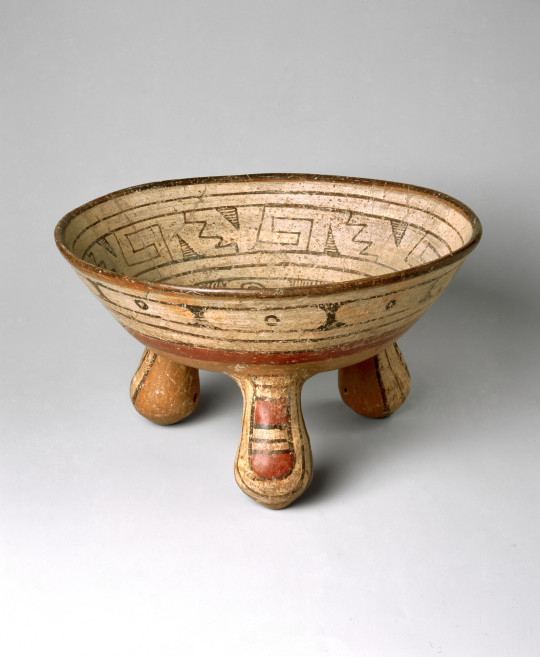
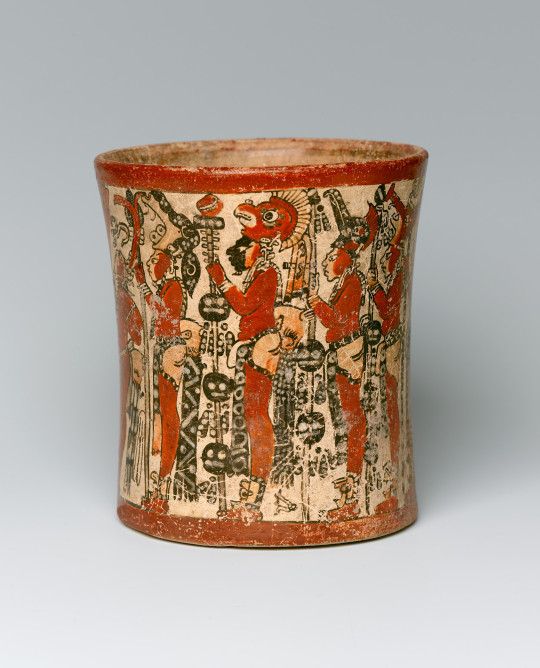
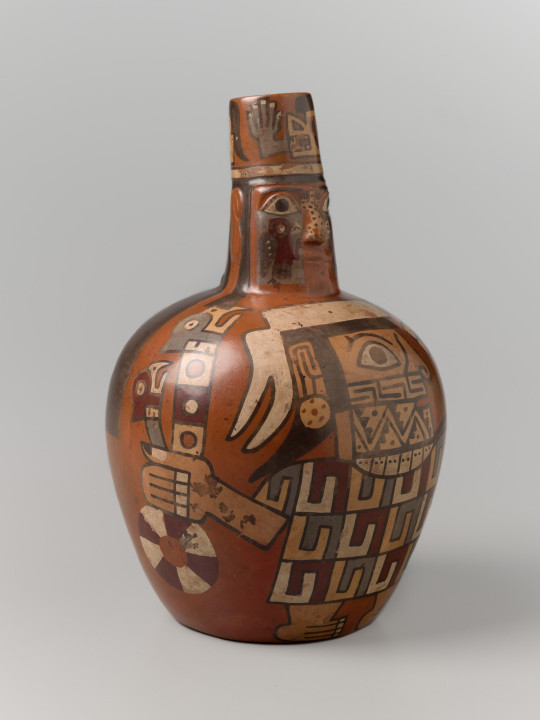
On #EarthDay and every day, we make an effort to acknowledge that we stand on land that is part of the unceded, ancestral homeland of the Lenape (Delaware) people. We are committed to addressing exclusions and erasures of Indigenous peoples, and confronting the ongoing legacies of settler colonialism in our work. By actively seeking collaborators, experience and perspectives from Indigenous communities, we work to ensure that our programming, resources and the ongoing community fostered at the Museum is inclusive of Native people.
Indigenous communities across the country have endured the catastrophic impacts of climate change but the situation has an even longer history rooted in the legacies of European colonialism. The artworks shown here are just a few examples of the varied and complex worldviews expressed by Indigenous artists impacted by environmental destruction.
These objects are part of “Climate in Crisis: Environmental Change in the Indigenous Americas,” on view in the Arts of the Americas Galleries on the fifth floor. The exhibit follows the effects of glacial melt, droughts, wildfires, overexploitation of resources, displacement, and extreme violence, as well as the work being done by Indigenous community organizers to counter the climate crisis and protect the planet.
🌎 http://bit.ly/2thoKME
📷 Aztec. Seated Figure of the Wind God (Ehecatl), ca. 1440-1521. Stone. Brooklyn Museum, By exchange, 48.22.6. Creative Commons-BY ⇨ Mixteca-Puebla. Tripod Bowl with Skull, 1000-1500. Ceramic, pigments. Brooklyn Museum, Carll H. de Silver Fund, 64.51.1. Creative Commons-BY ⇨ Maya. Cylindrical Vessel, ca. 550-950 C.E. Ceramic, pigment. Brooklyn Museum, Gift in memory of Frederic Zeller, 1998.176.2. Creative Commons-BY ⇨ Wari. Face Neck Jar, 650-1000 C.E. Ceramic, slip, pigments. Brooklyn Museum, Henry L. Batterman Fund, 41.418. Creative Commons-BY
#Brooklyn Museum#brooklyn#museum#art#earth day#native american art#indigeneous art#save our planet#climate crisis#bkmartsoftheamericas
158 notes
·
View notes
Photo

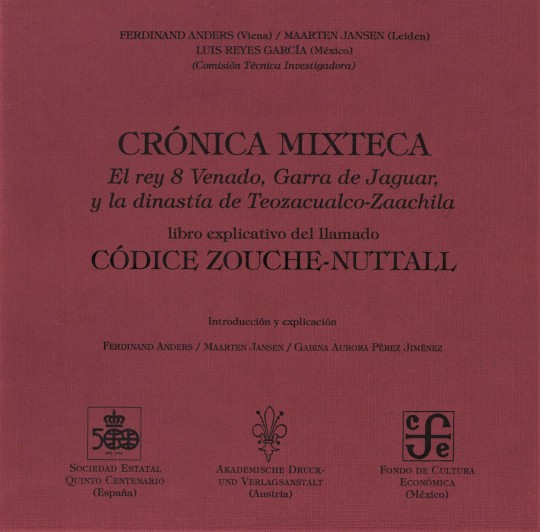

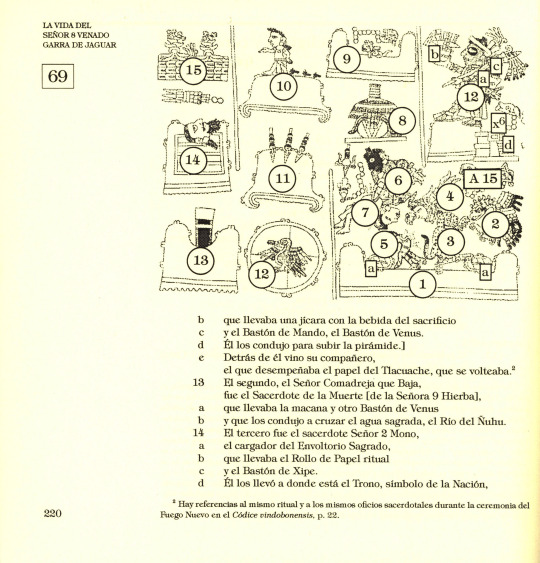

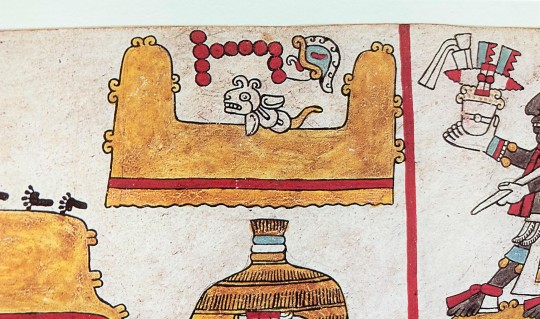



Día de los Muertos
Day of the Dead is not Mexican Halloween, it is a two-day Mexican celebration of the living and the dead, that overlaps with All Saints Day and All Souls Day. The celebration of death as a continuation of life could originate from the Aztec Lady of the Dead, Mictlancíhuatl. The days are filled with games, dance, and food at the ofrenda, oftentimes also at the cemetery where family and friends are buried. Most believe that the current tradition stems from a synthesis of Aztec and Catholic Spanish cultural traditions.
Our offering to celebrate is our facsimile edition of the Códice Zouche-Nuttall. The original codex is made of pieces of animal skins sewn in a screenfold style, likely made between the 13th and 14th centuries and currently housed in the British Museum. It details the dynastic reign of Oaxacan rulership of Tilantongo, in Mixtec logograph writing.
Our facsimile is a first edition printed in 1992 and accompanied by Crónica Mixteca: El rey 8 Venado, Garra de Jaguar, y la dinastía de Teozacualco-Zaachila, a book explaining the codex. Three scholars and organizations worked together to produce the commentary; Ferdinand Anders and Maarten Jansen with Akademische Druck-und Verlagsanstalt, Luis Reyes García with Sociedad Estatal Quinto Centenario and Fondo de Cultura Economica. The facsimile was printed in Austria while the accompanying text was printed in Mexico. Above we paired a page from the commentary with a page from the codex so that you can see how they identified each historical and mythological figure. We focused our imagery on the sacrificial scenes which are mimicked in the ofrenda’s of today!
To see our other Day of the Dead posts
To see our other facsimile posts
To see our posts on Mexican books and heritage
-Claire, Special Collections Graduate Intern
#claire#Dia de los Muertos#mixtec#axtec#ancestry#ofrendas#sacerdotes#All Souls Day#Mictlancihuatl#Codice Zouche-Nuttall#facsimile#commentary#Oaxaca#tilantongo#Ferdinand Anders#Maarten Jansen#Luis Reyes Garcia#Mexico#holidays
88 notes
·
View notes
Photo

We are so excited to welcome Brooklyn’s newest community fridge to this growing movement that believes everyone should be able to access healthy food without judgement. As of today there are now more than 90 active community fridges in the NYC area alone! We love to see the joy and passion of our fellow community fridge organizers when they celebrate the work and the community with festivities such as this and look forward to collaborating with @mixtecaorg and our friends at @southbrooklynmutualaid in the future. This fridge was painted by the amazingly talented @artbysandyperez #communityfridge #ayudamutua #solidaritynotcharity #mutualaid #foodnotbombs #spreadlove #anarchism #freedge #foodislovefoodislife #freeganismo #communitysolidarity #anarquismo #spreadthelove #goodworks #anarchist #sunsetparkbrooklyn #freeganism #feedthepeople #gifteconomy #foodisaright #anarchismo #freegan #zerowaste #sunsetpark #foodjustice #communitysupport #givebacktothecommunity #neighborshelpingneighbors #communitycare #allinthistogether (at Mixteca Organization, Inc.) https://www.instagram.com/p/CLQrRBcFsMf/?igshid=oyppre0fuen1
#communityfridge#ayudamutua#solidaritynotcharity#mutualaid#foodnotbombs#spreadlove#anarchism#freedge#foodislovefoodislife#freeganismo#communitysolidarity#anarquismo#spreadthelove#goodworks#anarchist#sunsetparkbrooklyn#freeganism#feedthepeople#gifteconomy#foodisaright#anarchismo#freegan#zerowaste#sunsetpark#foodjustice#communitysupport#givebacktothecommunity#neighborshelpingneighbors#communitycare#allinthistogether
1 note
·
View note
Photo

AllMusic Staff Pick:
Ry Cooder
Paris, Texas [Original Motion Picture Soundtrack]
1989
Roots Rock
Suggestive of both the imagery of Wim Wenders' movie and the desert itself, Cooder's score is a peaceful, poetic journey into the soul of an acoustic guitar. Stark and stylish, he makes the music sound at once alien and organic. "A Canción Mixteca" includes a memorable turn on vocals by Harry Dean Stanton singing in Spanish.
- Tim DiGravina
1 note
·
View note
Text
After ruling, hit film, Mexico reconsiders domestic workers
MEXICO CITY — The nanny shadowed the little boy around the garden party as he traced circles on a plastic scooter, climbed a pirate ship and occasionally paused for a sip of water under the blazing sun. She didn’t let him out of her sight.
It was a special day for Teo — his third birthday — and a typical weekend scene in affluent parts of Mexico. Viviana Lopez, 38, lives with Teo’s family of four in Mexico City, taking every other weekend off. As she wiped Teo’s nose, her own 8-year-old son was under the care of her parents in a town 2 1/2 hours from the capital.
Lopez has big plans: She wants her own house, and she is saving bit-by-bit in hopes of also opening her own beauty salon one day. She also wants a better life for her son, Jose Carlos: “I do this for him, for my little one,” Lopez said during a quick break while a grandmother watched Teo.
Extended hours and low wages have long dogged Mexican domestic workers, nine out of 10 whom are women. While many go home at night, plenty more are live-in servants, commonly referred to as “muchachas” — or girls — who get four days off each month. For some, days start by making breakfast for the families they serve, dressing children for school and then washing the dishes. The work extends well past sunset and entails being on-call for late-night babysitting and house parties. To rest, they retreat to small living quarters on patios and rooftops, in laundry rooms and behind kitchens.
Now Mexican society is looking inward to examine the role that domestic help plays in the country and the working conditions for its mostly female labour force. Domestic workers are in ample supply in a country where half the population of about 125 million lives in poverty, and it’s common for middle class families to employ one or more either full- or part-time. But labour laws are set to improve for the workers under new President Andres Manuel Lopez Obrador, who took office Dec. 1. And the recent Netflix movie “Roma” by Academy Award-winning director Alfonso Cuaron, portraying Mexican family life both good and bad, has broken the awkward silence around the relationships.
The Supreme Court ruled on Dec. 5 that Mexico’s more than 2 million domestic workers should be enrolled in the social security system, offering them greater rights as well as access to the public health system and free, government-run daycare. That change will come with a cost to employers, plus paperwork, while possibly improving the relationship between employee and worker. The coverage should cost about $400 a year, the equivalent of a month’s salary for many domestic workers.
Mexico has the lowest wages of any country in the Organization for Economic Cooperation and Development, with average monthly income per capita at $1,276. The OECD’s 35 members include much of the developed world and some developing nations.
Rocio Campos left a small ranch in the Pacific state of Guerrero when she was 12 to work in a Mexico City home. Forty-three years later, she cooks, cleans, shops for groceries and washes clothes for a niece of her first employer. That niece enrolled Campos in the social security system two years ago. Now she can afford medicine for arthritis, and save money.
Campos said she wants to work as long as she can so as not to be a burden on her three grown children. As she smashed black beans for lunch in her employer’s kitchen on a recent Friday, the single mother reflected on what free daycare will mean for younger domestic workers.
“You suffer the most when you go to work and don’t have anyone to leave them with,” she said.
The relationship between employer and employee is codependent and sometimes spans generations. Employers trust the women with what is most precious to them — children, jewelry and family heirlooms — in a country with a very weak criminal justice system. Nannies sometimes look after the children well into adulthood, caring for the children of their former charges. Domestic workers recommend cousins, sisters, aunts and mothers for work. Those recommendations are gold.
“They need our service, and we need the work,” said Maria Isidra Llanos, 52, who has been cleaning homes and caring for the children of other women since she was 15. At one of her first jobs, she recalls working until midnight because the workload was so heavy. Once she became a mother, the employer let her bring the baby, which she carted around the house in a wooden crate while she ironed, cooked and mopped.
The work felt endless: “I didn’t know how to put a stop to it,” Llanos said.
The employer-employee relationship is often intimate, as captured in Cuaron’s acclaimed “Roma,” which conveys the tenderness from a caregiver who sacrifices so much of her own life for the children and household of another. The movie also shows the disregard and even cruelty that many domestic workers suffer. Cuaron dedicated “Roma” to his childhood nanny, Libo.
Marcelina Bautista, a domestic worker turned activist, said the movie has helped highlight the plight of domestic workers who are afraid to ask for better working conditions. It’s also putting the topic into conversations across Mexico.
“Every time I see it I get very emotional,” Bautista said, her eyes watery after a recent screening. Like the film’s protagonist, Bautista came to work in a Mexico City household from Oaxaca at a young age, speaking mostly the indigenous language Mixteca. Now she runs a 1,500-strong union for domestic workers.
Cuaron rang Bautista on the phone recently to tell her to use the film as a tool, she said. And while the union is thrilled about the Supreme Court ruling on social security, its leaders are still fighting for contracts, shorter workdays and better wages.
Mexican labour law establishes a maximum 48-hour, six-day work week. But domestic workers fall into a grey area, with many putting in 12-hour days. Those who don’t live in often endure daily commutes of several hours in crowded public transportation between their homes in humble exurbs and their employers’ upscale residences.
From factories to offices, Mexicans work a lot. The average Mexican spends the equivalent of about 43 hours per week at work, more than in any other country in the OECD. Those long hours place heavy demands and expectations on all workers, with the biggest burden falling on those toward the bottom of the economic ladder.
Lopez has given a lot of children a lot of love in the 15 years since she started working as a nanny. Some children return that love, she says, while others don’t.
“It’s a great responsibility, but I find it satisfying,” she said. “It’s like taking care of my son — the same effort, the same care, the affection. You get attached to the children.”
She said she misses Jose Carlos the most at night, when Teo and his 8-year-old sister have gone to bed, or during meals, when she wonders whether he has eaten.
Jimena Gomez , Teo’s mother, said she’s extremely grateful for the help with her children and she thanks Lopez daily. Gomez herself works part-time in marketing, which is when she relies most heavily on Lopez for help.
“Mexico is a country where we have always been very comfortable in having help at home always, compared with other countries, because need leads people to work in the home,” Gomez said.
But she believes relationships between matriarchs and domestic workers are improving. Many moms like her are conscientious about scheduling breaks and limiting employees’ workdays to eight or 10 hours. Lopez’s starts well after Gomez has packed the kids’ lunches and shuttled them off to school. The nanny gets paid time off and an annual year-end bonus that’s standard for Mexican workers in the social security system.
Gomez said she completely supports domestic employees being enrolled in the national social security system.
“It is a job like any other,” Gomez said. “They have to have health protection, retirement, like everyone. It is a very dignified job.”
After ruling, hit film, Mexico reconsiders domestic workers published first on https://worldwideinvestforum.tumblr.com/
0 notes
Text
After ruling, hit film, Mexico reconsiders domestic workers
MEXICO CITY — The nanny shadowed the little boy around the garden party as he traced circles on a plastic scooter, climbed a pirate ship and occasionally paused for a sip of water under the blazing sun. She didn’t let him out of her sight.
It was a special day for Teo — his third birthday — and a typical weekend scene in affluent parts of Mexico. Viviana Lopez, 38, lives with Teo’s family of four in Mexico City, taking every other weekend off. As she wiped Teo’s nose, her own 8-year-old son was under the care of her parents in a town 2 1/2 hours from the capital.
Lopez has big plans: She wants her own house, and she is saving bit-by-bit in hopes of also opening her own beauty salon one day. She also wants a better life for her son, Jose Carlos: “I do this for him, for my little one,��� Lopez said during a quick break while a grandmother watched Teo.
Extended hours and low wages have long dogged Mexican domestic workers, nine out of 10 whom are women. While many go home at night, plenty more are live-in servants, commonly referred to as “muchachas” — or girls — who get four days off each month. For some, days start by making breakfast for the families they serve, dressing children for school and then washing the dishes. The work extends well past sunset and entails being on-call for late-night babysitting and house parties. To rest, they retreat to small living quarters on patios and rooftops, in laundry rooms and behind kitchens.
Now Mexican society is looking inward to examine the role that domestic help plays in the country and the working conditions for its mostly female labour force. Domestic workers are in ample supply in a country where half the population of about 125 million lives in poverty, and it’s common for middle class families to employ one or more either full- or part-time. But labour laws are set to improve for the workers under new President Andres Manuel Lopez Obrador, who took office Dec. 1. And the recent Netflix movie “Roma” by Academy Award-winning director Alfonso Cuaron, portraying Mexican family life both good and bad, has broken the awkward silence around the relationships.
The Supreme Court ruled on Dec. 5 that Mexico’s more than 2 million domestic workers should be enrolled in the social security system, offering them greater rights as well as access to the public health system and free, government-run daycare. That change will come with a cost to employers, plus paperwork, while possibly improving the relationship between employee and worker. The coverage should cost about $400 a year, the equivalent of a month’s salary for many domestic workers.
Mexico has the lowest wages of any country in the Organization for Economic Cooperation and Development, with average monthly income per capita at $1,276. The OECD’s 35 members include much of the developed world and some developing nations.
Rocio Campos left a small ranch in the Pacific state of Guerrero when she was 12 to work in a Mexico City home. Forty-three years later, she cooks, cleans, shops for groceries and washes clothes for a niece of her first employer. That niece enrolled Campos in the social security system two years ago. Now she can afford medicine for arthritis, and save money.
Campos said she wants to work as long as she can so as not to be a burden on her three grown children. As she smashed black beans for lunch in her employer’s kitchen on a recent Friday, the single mother reflected on what free daycare will mean for younger domestic workers.
“You suffer the most when you go to work and don’t have anyone to leave them with,” she said.
The relationship between employer and employee is codependent and sometimes spans generations. Employers trust the women with what is most precious to them — children, jewelry and family heirlooms — in a country with a very weak criminal justice system. Nannies sometimes look after the children well into adulthood, caring for the children of their former charges. Domestic workers recommend cousins, sisters, aunts and mothers for work. Those recommendations are gold.
“They need our service, and we need the work,” said Maria Isidra Llanos, 52, who has been cleaning homes and caring for the children of other women since she was 15. At one of her first jobs, she recalls working until midnight because the workload was so heavy. Once she became a mother, the employer let her bring the baby, which she carted around the house in a wooden crate while she ironed, cooked and mopped.
The work felt endless: “I didn’t know how to put a stop to it,” Llanos said.
The employer-employee relationship is often intimate, as captured in Cuaron’s acclaimed “Roma,” which conveys the tenderness from a caregiver who sacrifices so much of her own life for the children and household of another. The movie also shows the disregard and even cruelty that many domestic workers suffer. Cuaron dedicated “Roma” to his childhood nanny, Libo.
Marcelina Bautista, a domestic worker turned activist, said the movie has helped highlight the plight of domestic workers who are afraid to ask for better working conditions. It’s also putting the topic into conversations across Mexico.
“Every time I see it I get very emotional,” Bautista said, her eyes watery after a recent screening. Like the film’s protagonist, Bautista came to work in a Mexico City household from Oaxaca at a young age, speaking mostly the indigenous language Mixteca. Now she runs a 1,500-strong union for domestic workers.
Cuaron rang Bautista on the phone recently to tell her to use the film as a tool, she said. And while the union is thrilled about the Supreme Court ruling on social security, its leaders are still fighting for contracts, shorter workdays and better wages.
Mexican labour law establishes a maximum 48-hour, six-day work week. But domestic workers fall into a grey area, with many putting in 12-hour days. Those who don’t live in often endure daily commutes of several hours in crowded public transportation between their homes in humble exurbs and their employers’ upscale residences.
From factories to offices, Mexicans work a lot. The average Mexican spends the equivalent of about 43 hours per week at work, more than in any other country in the OECD. Those long hours place heavy demands and expectations on all workers, with the biggest burden falling on those toward the bottom of the economic ladder.
Lopez has given a lot of children a lot of love in the 15 years since she started working as a nanny. Some children return that love, she says, while others don’t.
“It’s a great responsibility, but I find it satisfying,” she said. “It’s like taking care of my son — the same effort, the same care, the affection. You get attached to the children.”
She said she misses Jose Carlos the most at night, when Teo and his 8-year-old sister have gone to bed, or during meals, when she wonders whether he has eaten.
Jimena Gomez , Teo’s mother, said she’s extremely grateful for the help with her children and she thanks Lopez daily. Gomez herself works part-time in marketing, which is when she relies most heavily on Lopez for help.
“Mexico is a country where we have always been very comfortable in having help at home always, compared with other countries, because need leads people to work in the home,” Gomez said.
But she believes relationships between matriarchs and domestic workers are improving. Many moms like her are conscientious about scheduling breaks and limiting employees’ workdays to eight or 10 hours. Lopez’s starts well after Gomez has packed the kids’ lunches and shuttled them off to school. The nanny gets paid time off and an annual year-end bonus that’s standard for Mexican workers in the social security system.
Gomez said she completely supports domestic employees being enrolled in the national social security system.
“It is a job like any other,” Gomez said. “They have to have health protection, retirement, like everyone. It is a very dignified job.”
from Financial Post https://ift.tt/2T1uIIP
via IFTTT Blogger Mortgage
Tumblr Mortgage
Evernote Mortgage
Wordpress Mortgage
href="https://www.diigo.com/user/gelsi11">Diigo Mortgage
0 notes
Photo

Ceiba #ceiba #pochote #laceiba #plants #plantslover #nature #naturelovers #natura #green #organic #textura #texturelovers #spins #greenplants #garden #gardening #lines #mexicolors #mexicoandando #proyectomexico #mexicoesmagia #mextagram #igersmexico #plantasdemexico #naturalista #naturelovers #oax #mixteca #land #notfilter #canonphotography
#notfilter#pochote#proyectomexico#gardening#plantasdemexico#textura#nature#naturelovers#naturalista#ceiba#oax#igersmexico#mexicoandando#natura#green#mexicolors#lines#texturelovers#plantslover#mixteca#spins#organic#mexicoesmagia#greenplants#canonphotography#land#plants#laceiba#garden#mextagram
0 notes
Text
Questionaire from Peace Corps West
A representative from Peace Corps West Region sent me an email announcing that Himboldt State had been ranked amoung the top volunteer producing universities this year. Here are my answers to the questionaire. 1. What is your initial reaction to this exciting announcement? When I attended HSU, I was told that it recruited the most volunteers of any other California State University. I was glad to hear that it continues to be the kind of university that produces a lot of volunteers! 2. How did your time in college prepare you for Peace Corps service? Humboldt State was a good place for me to learn about organic gardening because the region is full of community supported agriculture; it was a perfect place to combine my formal environmental education with hands on learning like farming. Also, it was a place where local food culture was very much alive, which has played a role in my service as an environmental education volunteer. 3. What would you say to encourage current students or alumni to join the Peace Corps? I'd say that in many countries a social service, usually of about a year, is required of undergrads before receiving their degree. It serves the double purpose of a useful practice of skills acquired during college, and of giving back to society. I consider my Peace Corps service a social service, and it has definitely helped me develop practical skills from the theoretical skills I learned in college. 4. How do you feel you’re making a differences in your service? I'm serving in Mexico, so I see the service as very relevant in this day and age, to create goodwill and tell a story about Americans to Mexicans as a Mexican-American myself. As far as the content of my service, I feel that I am helping spread the concept of environmental stewardship through hands-on work with young people in appropriate technology and sustainable agriculture, and in environmental interpretation through mural work in the botanical garden at my site. 5. What has been the highlight of your service? As the son of an immigrant, the highlight of my service has been serving in the country that my dad left in order to provide for his family. 6. Brief description of your job as Peace Corps volunteer: I work in an indigenous community in Southern Mexico in a region known as the Mixteca, where crops like corn and beans were first domesticated. I work with high schoolers developing an organic garden growing these ancestral crops. We also work with appropriate technologies so that the site functions off-grid. My secondary project is in environmental interpretation at a botanical garden, painting interpretive murals. 7. Major and year of graduation: B.S. Environmental Science & Management; Climate & Energy 2013
0 notes
Photo
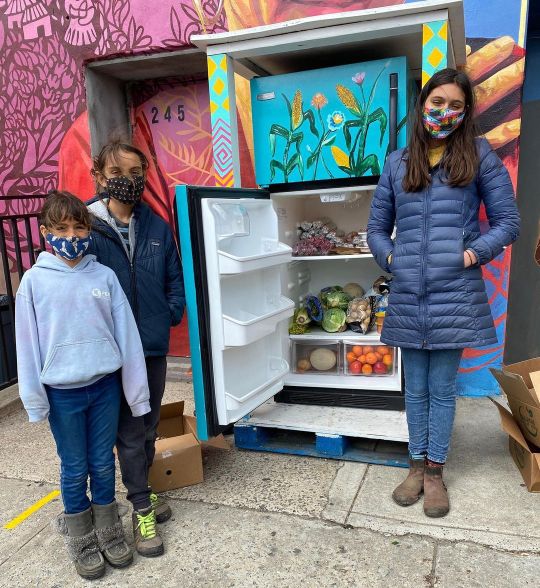
For the third day in a row we’ve organized the rescue of more than 3,000 pounds of food that would otherwise have gone to waste. This food made it into community fridges thanks to @breadandlife @lucylaser @bettypz0 @mallicent @fenixcommunityfridge @smallthingsgrowhomebirth @ebenkensho, Rabbi David and many more! We love to see mutual aid practiced as a multigenerational family affair by so many people in this network! Repost: @smallthingsgrowhomebirth ・・・ Spent this windy Thursday driving around Brooklyn picking up a food donation and distributing to three community fridges on behalf of @iohnyc. These three were super industrious, opening up boxes, unloading into fridges, and breaking down the boxes. My midwifery is my mothering is my politics is my midwifery is my mothering, and I wouldn’t be a midwife without the others. It’s all entwined. I am so grateful I have the kids I have and they want to do this work with me. #unschooling #communitycare #carenotcops #communitysupport #mutualaid #homeschooling #midwifelife #parentingispolitical #dothework #solidaritynotcharity #foodnotbombs #neighborshelpingneighbors #feedthepeople #ayudamutua #spreadthelove (at Mixteca Organization, Inc.) https://www.instagram.com/p/CN_FIKBDfIq/?igshid=o2tcuamuyd0u
#unschooling#communitycare#carenotcops#communitysupport#mutualaid#homeschooling#midwifelife#parentingispolitical#dothework#solidaritynotcharity#foodnotbombs#neighborshelpingneighbors#feedthepeople#ayudamutua#spreadthelove
0 notes